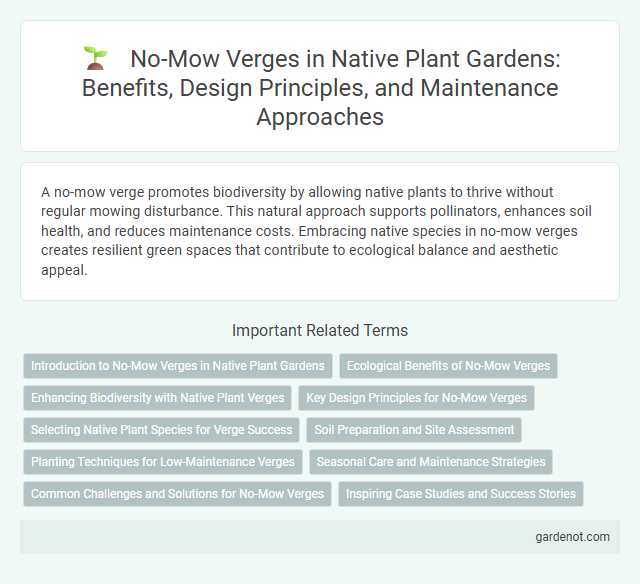A no-mow verge promotes biodiversity by allowing native plants to thrive without regular mowing disturbance. This natural approach supports pollinators, enhances soil health, and reduces maintenance costs. Embracing native species in no-mow verges creates resilient green spaces that contribute to ecological balance and aesthetic appeal.
Introduction to No-Mow Verges in Native Plant Gardens
No-mow verges in native plant gardens enhance biodiversity by allowing indigenous grasses and wildflowers to flourish without regular mowing stress. These low-maintenance strips support pollinators and wildlife, creating critical habitats within urban and suburban landscapes. Implementing no-mow verges reduces carbon emissions from lawn equipment while promoting soil health and ecological resilience.
Ecological Benefits of No-Mow Verges
No-mow verges support biodiversity by providing native plants with a habitat that sustains pollinators such as bees and butterflies, enhancing local ecosystems. Reduced mowing decreases soil disturbance, promoting healthier soil microbiomes and carbon sequestration, which helps mitigate climate change. These verges also improve water retention and reduce runoff, contributing to improved urban stormwater management.
Enhancing Biodiversity with Native Plant Verges
No-mow verges planted with native species significantly enhance urban biodiversity by providing essential habitats for pollinators, birds, and beneficial insects. These native plant verges improve soil health, increase local flora diversity, and support ecological connectivity in fragmented landscapes. Maintaining no-mow zones reduces lawn maintenance emissions while promoting resilient ecosystems tailored to regional climates.
Key Design Principles for No-Mow Verges
No-mow verges emphasize low-maintenance native plant species that enhance biodiversity while reducing water use and mowing requirements. Selecting deep-rooted perennial natives ensures soil stability and supports local wildlife habitats effectively. Designing with diverse plant heights and textures creates resilient ecosystems that thrive in various environmental conditions without frequent human intervention.
Selecting Native Plant Species for Verge Success
Selecting native plant species for a no-mow verge prioritizes drought-tolerant, low-maintenance varieties such as *Echinacea purpurea*, *Asclepias tuberosa*, and *Rudbeckia hirta* that thrive in local soil conditions. Incorporating deep-rooted grasses like *Panicum virgatum* enhances soil stability and supports native pollinators, promoting ecological balance. Choosing species adapted to the specific climate zone ensures long-term survival and reduces the need for supplemental watering and fertilization.
Soil Preparation and Site Assessment
Effective soil preparation and site assessment are critical steps for establishing a thriving no-mow verge with native plants. Conduct soil tests to determine pH, nutrient levels, and texture, enabling targeted amendments that promote native species growth and drought resilience. Assess sunlight exposure, drainage patterns, and existing vegetation to select appropriate native plants that require minimal maintenance and support local biodiversity.
Planting Techniques for Low-Maintenance Verges
No-mow verges thrive by selecting native grasses and wildflowers adapted to local soil and climate conditions, reducing the need for frequent mowing and irrigation. Deep-rooted plants like blue grama and little bluestem improve soil stability and drought resilience, ensuring long-term sustainability. Strategic planting in clusters maximizes pollinator habitat while minimizing invasive species encroachment, creating a balanced, low-maintenance landscape.
Seasonal Care and Maintenance Strategies
No-mow verges featuring native plants require seasonal care to ensure ecological balance and aesthetic appeal. Implement targeted pruning in early spring to remove dead growth and stimulate new native shoot development while preserving soil integrity. Conduct mulching and selective weeding during summer to suppress invasive species and maintain moisture levels essential for native flora resilience.
Common Challenges and Solutions for No-Mow Verges
No-mow verges often face challenges such as invasive weed encroachment, uneven growth, and potential fire hazards due to accumulated dry vegetation. Effective solutions include selecting hardy native plant species with deep root systems to outcompete weeds, scheduled strategic trimming to manage biomass without sacrificing biodiversity, and applying mulch to retain soil moisture and suppress unwanted plants. Regular community engagement and education on the ecological benefits of no-mow zones further support long-term maintenance and ecosystem health.
Inspiring Case Studies and Success Stories
No-mow verges featuring native planting have transformed urban landscapes by reducing maintenance costs and enhancing biodiversity, as seen in cities like Portland, Oregon, where pollinator populations increased by 40%. In Melbourne, Australia's no-mow verge projects led to a 30% rise in native bird species, demonstrating ecological benefits and community engagement. These inspiring case studies highlight how integrating native plants in no-mow verges fosters sustainable, vibrant ecosystems while promoting environmental stewardship.
No-mow verge Infographic

 gardenot.com
gardenot.com